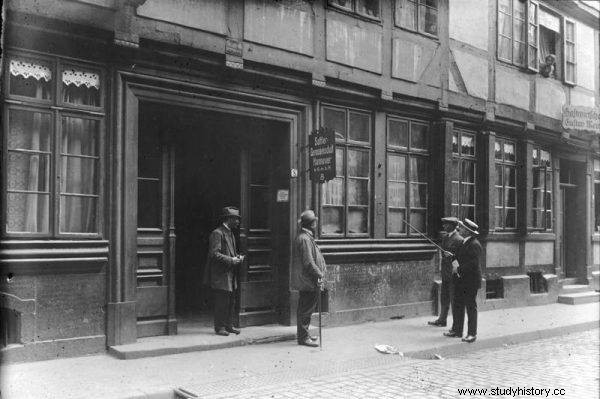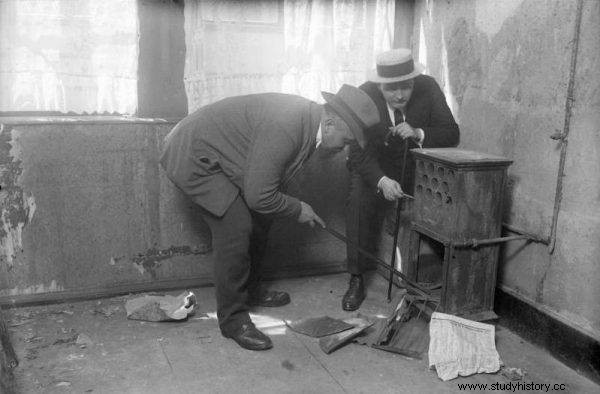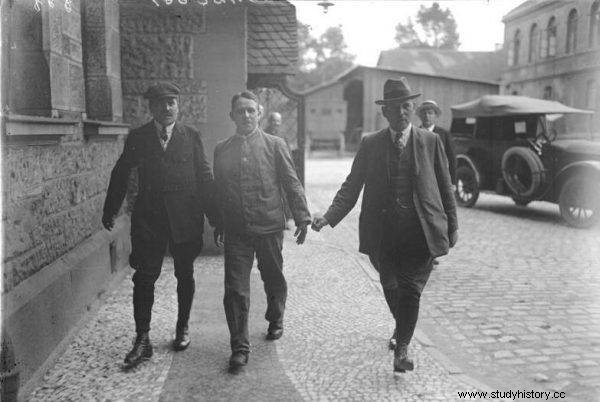In September 1918, the police visited the apartment of Fritz Haarmann, a Hanoverian meat trader, in connection with the reported missing 17-year-old Friedel Rothe. The visit did not help find the young man, but resulted in Fritz being sentenced to nine months in prison. Reason? Officers found him in bed with a 13-year-old. If they had looked around, they would have found a paper bag behind the stove with Friedel's head in it - the first victim of the Hanover butcher.
Fritz was born in 1879 as Friedrich Heinrich Karl Haarmann. He was the youngest of six children of Ollie and Johanna. His father worked as a locomotive and was famous for his impulsive character. The mother of the future murderer tried to compensate her son for this difficult relationship by pampering him.
He himself seemed to be a withdrawn and reticent child, which was clearly reflected in his experiences during the first years of school. His friends mocked him for his "effeminate" lifestyle, and one of the teachers abused little Fritz sexually . The trauma of these events had an impact on the boy's psyche and directed him to the dark recesses from which one of the most famous German criminals was soon to be born.
At the age of 16, Fritz committed his first sexual crimes. He chose young boys as his victims, and then lured them to dark cellars and raped them. Eventually, he was arrested by the police and brought to justice for the first time. The court found that the accused was an incurable case of a mentally ill person and sentenced him to a stay in a psychiatric hospital. Fritz, however, did not plan to stay there too long. At the first possible opportunity, he fled, and then decided to try a "normal" life.

The building where the Hannover butcher's flat was located.
He got engaged to Erna Loewert, but the relationship was not a happy one. Fritz was always jealous of his partner, which caused many quarrels and unpleasant situations. Additionally, Erna became pregnant with him, which she eventually decided to terminate. All of this led to a broken engagement.
Professional life was also not going according to Fritz's plan. Service in the army, despite the man's best wishes, was not meant for him for health reasons. As for the other jobs, he couldn't hold any longer. Constant theft and other petty crimes meant that from 1905 until the end of World War I, he was a regular "guest" at the local prison.
After the end of the war, Germany woke up in a new and extremely difficult reality. Fritz took up any activities that allowed him to earn a piece of bread. He was, inter alia, a seller of meat and clothes at a local market, but especially profitable was the position of ... a police informant . A rich criminal record made Haarmann a great informer. Despite being labeled "homosexual" in the papers, Fritz gained freedom of action through this collaboration - including (ironically!) As a serial killer.
Life outside the law
Haarmann's first victim was the abovementioned Friedel Rothe in 1918. The boy was last seen with a smartly dressed man whose description matched Fritz's. Unfortunately, an investigation into his case was not pursued, and Haarmann - after serving a prison sentence for prostitution with a 13-year-old - left prison free from all other suspicions.
In 1919, Fritz met 18-year-old Hans Grans, who quickly became his lover and partner in crime. They hunted for their victims mainly near the train station, targeting poor boys. Haarmann, with his elegant clothes and pleasant nature, inspired the confidence of teenagers, whom he then offered to help in the form of a warm meal and shelter. After luring the boys to their apartment, he sexually abused them, then murdered them, dismembered them, and probably sold the meat (and any remaining clothes or other trinkets) at the local market. He threw the bones into the Leine River.

Traces of blood were found in Fritz's apartment, as well as clothes and other items belonging to the missing boys.
In the testimony that Fritz later gave in court, he admitted how he dealt with the bodies:“I made two cuts in the abdomen, I put the entrails into a bucket. I took out the blood, crushed the bones, (...) took out the heart, lungs and kidneys, cut them up and put them in a bucket. I peeled the bones from the meat. ”
His criminal activities lasted for 5 years, during which he killed at least 27 people, although Haarmann himself later boasted that there were many more victims. However, although other mysterious disappearances of young boys were reported to the police - along with clues suggesting Fritz's participation - the services were not eager to investigate their trusted informant. But things were about to change soon.
A gruesome discovery
On May 17, 1924, a group of children playing by the Leine River made a gruesome discovery. They found a human skull on the shore. Initially, the police downplayed the matter, blaming the medical department "jokers" or grave robbers. Over time, however, more and more remains were discovered, until a sack containing human shinbones and ribs from at least twenty victims was finally found .
This forced the officers to act. Traces and evidence discovered during the investigation began to point to Fritz Haarmann. A search of his apartment was ordered, during which both traces of blood were found, as well as clothes and other items belonging to the missing boys. A police informant has been arrested.

Hanover butcher escorted by detectives on his way to court
The trial of the Hanover butcher was followed not only by the city's residents, but also by the international media. Almost 200 witnesses were questioned:the killer's neighbors, his clients and people who knew the killed teenagers. Would-be victims were also found - boys whom the man invited home, slept with them, and released them slowly the next day.
Among the stories presented to the court, there were also those with a strange taste of meat, which Fritz sold as pork. And although Haarmann himself never admitted to trading in "humans", after this testimony, the sale of meat in the country dropped significantly.
Ultimately, 45-year-old Fritz was sentenced to death by guillotine beheading . His partner, Hans Grans, was sentenced to 15 years in prison. Haarmann took the sentence calmly. He did not intend to appeal. In his defense, he only said that he was killing out of a love that no one could understand except him. The execution was carried out on April 15, 1925.
After his death, the head of the Hanover butcher was preserved in formalin and transferred to the Institute of Anatomy in Göttingen. It was cremated only recently. The final number of Fritz casualties has also never been established. He himself was to claim that there were up to 40 of them, and his partner later mentioned as many as 70 people.
The history of these crimes became one of the inspirations for Fritz Lang and his 1931 film "M".
Bibliography
- Poppek, 20th century serial killers true stories , G + J Books, 2013.
- https://tvn24.pl/magazyn-tvn24/mogl-bezkarnie-zabijac-jako-informator-dla-policji-byl-zbyt-cenny,48,1085 / accessed:18.01.2021.
- https://www.arte.tv/pl/videos/069116-007-A/fritz-haarmann-wampir-z-republiki-weimarska/ / accessed:18.01.2021.
- https://www.youtube.com/watch?v=x-zfB7VMtGw / accessed:18.01.2021.
- https://www.archiwumzbrodni.pl/byl-popularnym- Sprzedaż-dopoki-nie-odkryto-ze-jego-mieso-jest-ludzkie/ / accessed:01/18/2021.
